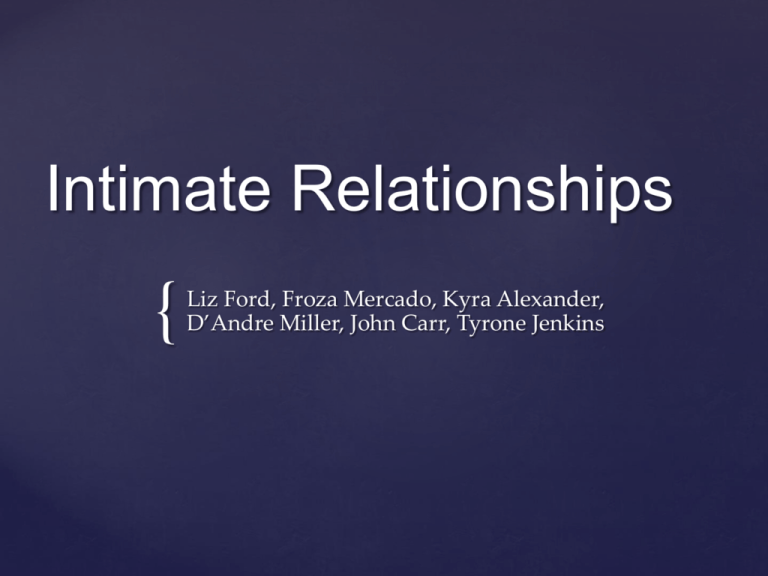
Intimate Relationships
{
Liz Ford, Froza Mercado, Kyra Alexander,
D’Andre Miller, John Carr, Tyrone Jenkins
Developing a Relationship
Friendships (The first relationships we form outside of the family)
Include the following :
1. Companionship: Friends are usually happy and
relaxed when they are around each other
2. Respect: show respect by being honest
3. Acceptance: They accept each other. They can be
themselves without feeling criticized.
4. Help: Friends know they can rely on each other in times of
need.
5. Trust: They feel safe confiding in each other
6. Loyalty: Friends stand up for each other
7. Mutuality: Friends share the ups and downs of each other’s lives.
8. Reciprocity: Give- and – take
Choosing a Partner
Lives in the same geographic area
Is from similar ethnic and socioeconomic
background
Has similar educational attainment
Lives a similar lifestyle
Is like them in terms of physical
attractiveness
Communication
The keys to good communication in relationships:
Self-disclosure
Listening
Feedback
Non Verbal- 65% communication is non verbal
-Ability to interpret non verbal messages
Understand differences in communication by gender:
-Men try to establish dominance and listen less
-Women seek advice and pay attention to body
language
Challenges in a Relationship
Unequal or Premature Commitment
Unrealistic Expectations
Competitiveness
Balancing time together and apart
Jealousy
Supportiveness
Unhealthy Relationships
Could be physically or mentally abusive
Lacks love and respect
Too much criticism, contempt, defensiveness
and withdraw
Cohabitation
Cohabitation: Living together in a sexual relationship without
being married.
Cohabiting couples have a 51% chance of marrying after 3 years
together
Advantages:
Lowers the cost of living
Emotional support and sexual relations without the
commitment of marriage
Tests your compatibility before agreeing to marriage
Traditional Marriage:
Between Man and Woman
Heterosexual union, social or legal union between
opposite sex couples
Heterosexual: Emotional and sexual attraction to
people of the other sex
Characteristics of a happy
Marriage:
Realistic expectations about the relationship
Good communication skills
Agree on religious/ethical values
Resolve conflicts effectively
Mutual trust
Equal roles
Balance of interests
The Benefits of Marriage
Affection
Personal affirmation
Companionship
Sexual Fulfillment
Emotional Growth
Can provide a setting to raise children
Same-Sex Relationships
Sexual Orientation: A consistent pattern of emotional and
sexual attraction based on biological sex.
- It exists along a continuum that ranges from exclusive
heterosexuality, bisexuality, to exclusive
homosexuality.
Bisexuality & Homosexuality
Bisexuality: emotional and sexual attraction of people of both sexes
(male and female).
Homosexuality: emotional and sexual attraction to people of one’s
own sex (male-male; female-female).
Similarities with heterosexual couples:
Same-sex partnerships provide intimacy, passion, and
security.
Same-sex partnerships tend to be more equal and less organized
around traditional gender roles:
-Greater emphasis on partnership than role assignment.
-Domestic tasks are split.
LGBTQI
People with diverse sexual orientations and gender identities
are often grouped together.
Lesbian: Female-Female
Gay: Male-Male
Bisexual: Female/Male
Transgendered: people who’s biological sex doesn’t match
their gender identity
Questioning or Queer
Intersex: people born with ambiguous genitals
Controversy of Same-Sex
Relationships
1. Societal hostility or ambivalence
Homophobia: fear or hatred of homosexuals
There can be violence, discrimination, or can be subtle.
2. Religious views also play a role in same-sex
relationship controversy.
Politics- presidential support
3. Problems with family may arise when individual
“comes out”
Family trouble with acceptance of same-sex relationship or
same sex marriage.
Legalization of Gay Marriage
Marriage between the same sex
Proponents argue that same-sex couples should have access to
the same marriage benefits and public acknowledgment
enjoyed by heterosexual couples and that prohibiting gay
marriage is unconstitutional discrimination.
Opponents argue that altering the traditional definition of
marriage as between a man and a woman will further weaken
a threatened institution and that legalizing gay marriage is a
slippery slope that may lead to polygamous and interspecies
marriages.
States with Legalized Gay
Marriage
Massachusetts (May 17, 2004)
Connecticut (Nov. 12, 2008)
Iowa (Apr. 24. 2009)
Vermont (Sep. 1, 2009)
New Hampshire (Jan. 1, 2010)
New York (June 24, 2011)
Washington (Dec. 9, 2012)
Maine (Dec. 29, 2012)
Maryland (Jan. 1, 2013)
California (June 28, 2013)
Delaware (July 1, 2013)
Rhode Island (Aug. 1, 2013)
Minnesota (Aug. 1, 2013)
New Jersey (Oct. 21, 2013)
Hawaii (Dec. 2, 2013)
Illinois (law will take effect June 1, 2014)
Common Law
A marriage existing by mutual agreement between a man and a
woman, or by the fact of their cohabitation, without a civil or
religious ceremony.
Divorce Rates
Divorce
First Marriage: 45% to 50% marriages end in divorce
Second Marriage: 60% to 67% marriages end in divorce
Third Marriage: 70% to 73% marriages end in divorce
Couples With Children: 40%
Couples Without Children: 66%






